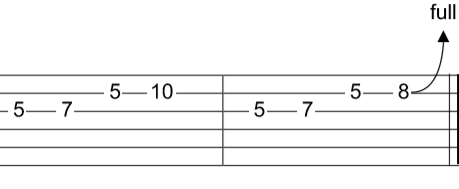
All guitar players should learn to train their ears so they are able to accurately listen for pitch relative to its starting point. This will help all of us when it comes to playing along with a song and trying to work out which chord or note is next, or being able to make creative decisions about pitch mid guitar solo. This lesson won’t give you perfect pitch, but it will improve your string bending and your ability to target a pitch. This is the first step to training your ears to identify every detail of the music you play.
Guitar Tricks features an extensive Guitar Glossary in the toolbox. From the glossary, pitch is defined as the frequency of a sound, relating to sound waves. A pitch can be described as high (squeaky and biting) or low (sonorous and warm). Sound is really created by vibrations, which essentially squash bits of air closer together and vibrate the eardrum. The amount of vibrations per second determines the pitch of the sound.
Let’s start with a short concept. On the G string, play the 5th and 7th frets one after the other. Then, play them again, but this time, instead of playing the 7th fret, you want to double up on the 5th fret and bend it a full step up to the pitch of the 7th fret. Playing the 7th fret on the first go will allow you to hear the difference between the 2 notes. The bend then takes you from one pitch to the other.
Playing the 7th fret on the first go will allow you to hear the difference between the 2 notes. The bend then takes you from one pitch to the other.
The key here is to listen to the target note, and then try to hit it with the bend. Having heard the note for reference before the bend, you should be able to tell yourself if you’ve hit the pitch correctly, or if you’ve gone sharp or flat.
We can also extend the pattern to 3 notes. This will provide 3 notes for the ear, 2 of which are before the target pitch. This can be slightly harder as there is more information for your brain to process. If you imagine the scenario of trying to hear a specific note in a song, chances are there will be multiple notes before it.
Here is another example which involves us going up to the target pitch, back down to the note before and then bending up to the target again.
You could also use scale patterns to practice these exercises. This is taken from the A Minor Pentatonic scale: This deals with some larger pitch jumps, the first bar ending with the target note and the second bar ending with a bend up to the target. This will be the closest to what you’d see if you were improvising.
This deals with some larger pitch jumps, the first bar ending with the target note and the second bar ending with a bend up to the target. This will be the closest to what you’d see if you were improvising.
Performing these little ear training exercises will help build your perception of pitch. Hearing when notes are in tune is a very useful asset for all guitar players to have. If you are brand new to ear training and want to ease yourself in, perform these exercises with an electronic tuner switched on. That will allow you to see the pitches you’re playing, and you’ll be able to see on the tuners display when the note you are bending has reached its target.
Ear training isn’t a skill that you’re going to develop overnight so be patient. It takes a while to develop a critical ear. Enjoy it and test yourself regularly. You’re about to get into a whole new world of hearing how you play.
About the Author
Leigh Fuge is a guitar teacher and musician from the Swansea in the UK. He works as a guitar teacher, producer and session guitarist as well as providing guitar-based content for many high-profile sources online and in printed magazines. He has helped hundreds of students in guitar lessons to achieve their potential.

